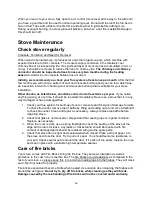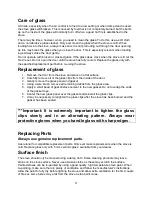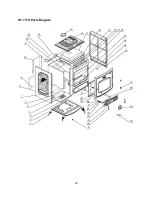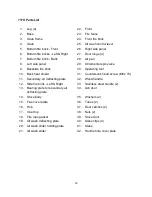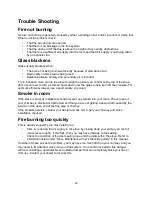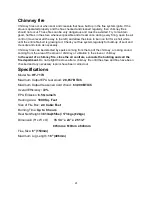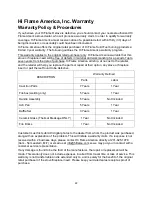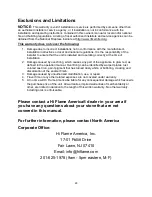
20
Trouble Shooting
Fire not burning
A stove not burning is generally caused by either a shortage of air and/or incorrect or damp fuel.
If fuel is not the problem check:
• That the air controls are opened.
• That there is no blockage in the flue system.
• That the open end of the flue is above the height of any nearby obstructions.
• That there is a sufficient air supply into the room and that this supply is not being taken
by an extractor fan.
Glass blackens
Glass usually blackens when:
• The fuel is not being burned efficiently because of starvation of air.
• Bad quality or damp fuel is being used.
• Balance between primary and secondary air is incorrect.
Try to introduce more air into the stove through the primary air control on the top of the stove
door (move lever to left), as this air flows down over the glass to help burn off the creosote. For
optimum efficiency always use a good quality, dry wood.
Smoke in room
If the stove is properly installed it should not emit any smoke into your room. Check to see if
your chimney is blocked or obstructed and that you are not getting a down draft caused by the
location of the open end of the flue pipe or chimney.
If the problem persists, contact your dealer and ask him to get your chimney and stove
installation checked.
Fire burning too quickly
This is usually caused by too much draft or air.
• First, try reducing the air supply to the stove by closing down your primary air control
(move lever to right). If this fails, then you may have damage to the sealing.
• Check the condition of the door sealing rope and the joints within the stove. Refer to
information listed under “Stove Maintenance-Check Stove Regularly” in this manual.
If neither of these solves the problem, you may have too much draft on your chimney and you
may need to fit a damper valve into your flue system. You should not install a flue damper
without consulting a specialist. Never install a damper that can completely block your flue or
chimney. Contact your dealer to discuss this.











